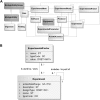Life sciences domain analysis model
- PMID: 22744959
- PMCID: PMC3486731
- DOI: 10.1136/amiajnl-2011-000763
Life sciences domain analysis model
Abstract
Objective: Meaningful exchange of information is a fundamental challenge in collaborative biomedical research. To help address this, the authors developed the Life Sciences Domain Analysis Model (LS DAM), an information model that provides a framework for communication among domain experts and technical teams developing information systems to support biomedical research. The LS DAM is harmonized with the Biomedical Research Integrated Domain Group (BRIDG) model of protocol-driven clinical research. Together, these models can facilitate data exchange for translational research.
Materials and methods: The content of the LS DAM was driven by analysis of life sciences and translational research scenarios and the concepts in the model are derived from existing information models, reference models and data exchange formats. The model is represented in the Unified Modeling Language and uses ISO 21090 data types.
Results: The LS DAM v2.2.1 is comprised of 130 classes and covers several core areas including Experiment, Molecular Biology, Molecular Databases and Specimen. Nearly half of these classes originate from the BRIDG model, emphasizing the semantic harmonization between these models. Validation of the LS DAM against independently derived information models, research scenarios and reference databases supports its general applicability to represent life sciences research.
Discussion: The LS DAM provides unambiguous definitions for concepts required to describe life sciences research. The processes established to achieve consensus among domain experts will be applied in future iterations and may be broadly applicable to other standardization efforts.
Conclusions: The LS DAM provides common semantics for life sciences research. Through harmonization with BRIDG, it promotes interoperability in translational science.
Conflict of interest statement
Figures



References
-
- HL7 International Domain Analysis Model. 2008. http://wiki.hl7.org/index.php?title=Domain_Analysis_Model (accessed 21 Sep 2011).
-
- Ambler SW. Agile Modeling. UML 2 Class Diagram Guidelines. http://www.agilemodeling.com/style/classDiagram.htm (accessed 22 Sep 2011).
-
- National Cancer Institute Life Sciences Domain Analysis Model (LS DAM). 2011. https://wiki.nci.nih.gov/x/cxRlAQ (accessed 21 Sep 2011).
-
- FuGE | Home Page Functional Genomics Experiment (FuGE) Home Page. http://fuge.sourceforge.net (accessed 28 Apr 2011).
Publication types
MeSH terms
LinkOut - more resources
Full Text Sources
Other Literature Sources

